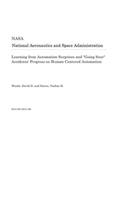
Learning from Automation Surprises and "going Sour" Accidents
Series:
Advances in technology and new levels of automation on commercial jet transports has had many effects. There have been positive effects from both an economic and a safety point of view. The technology changes on the flight deck also have had reverberating effects on many other aspects of the aviation system and different aspects of human performance. Operational experience, research investigations
NaN
VOLUME
English
Paperback

Advances in technology and new levels of automation on commercial jet transports has had many effects. There have been positive effects from both an economic and a safety point of view. The technology changes on the flight deck also have had reverberating effects on many other aspects of the aviation system and different aspects of human performance. Operational experience, research investigations, incidents, and occasionally accidents have shown that new and sometimes surprising problems have arisen as well. What are these problems with cockpit automation, and what should we learn from them? Do they represent over-automation or human error? Or instead perhaps there is a third possibility - they represent coordination breakdowns between operators and the automation? Are the problems just a series of small independent glitches revealed by specific accidents or near misses? Do these glitches represent a few small areas where there are cracks to be patched in what is otherwise a record of outstanding designs and systems? Or do these problems provide us with evidence about deeper factors that we need to address if we are to maintain and improve aviation safety in a changing world? How do the reverberations of technology change on the flight deck provide insight into generic issues about developing human-centered technologies and systems (Winograd and Woods, 1997)? Based on a series of investigations of pilot interaction with cockpit automation (Sarter and Woods, 1992; 1994; 1995; 1997a, 1997 b), supplemented by surveys, operational experience and incident data from other studies (e.g., Degani et al., 1995; Eldredge et al., 1991; Tenney et al., 1995; Wiener, 1989), we too have found that the problems that surround crew interaction with automation are more than a series of individual glitches. These difficulties are symptoms that indicate deeper patterns and phenomena concerning human-machine cooperation and paths towards disaster. In addition, we find the same kinds of p...
Price Comparison [India]
In This Series
Bestseller Manga
Trending NEWS




















